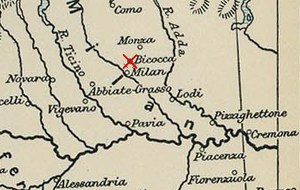
Back معركة بيكوكا Arabic Emgann Bicocca Breton Batalla de Bicocca Catalan Schlacht bei Bicocca German Batalla de Bicoca Spanish Bicoccako gudua Basque Bataille de la Bicoque French Batalla de Bicoca Galician Bicoccai csata (1522) Hungarian Pertempuran Bicocca ID
| Battle of Bicocca | |||||||
|---|---|---|---|---|---|---|---|
| Part of the Italian War of 1521–26 | |||||||
 Lombardy in 1522. The location of the battle is marked. | |||||||
| |||||||
| Belligerents | |||||||
| Commanders and leaders | |||||||
| |||||||
| Strength | |||||||
| 19,000–31,000+[1] | 18,000+[2] | ||||||
| Casualties and losses | |||||||
| 3,000+ killed | 1–200 killed[3] | ||||||
Location of the battlefield in present-day Lombardy | |||||||
The Battle of Bicocca or La Bicocca (Italian: Battaglia della Bicocca) was fought on 27 April 1522, during the Italian War of 1521–26. A combined French and Venetian force under Odet de Foix, Vicomte de Lautrec, was decisively defeated by an Imperial–Spanish and Papal army under the overall command of Prospero Colonna. Lautrec then withdrew from Lombardy, leaving the Duchy of Milan in Imperial hands.
Having been driven from Milan by an Imperial advance in late 1521, Lautrec had regrouped, attempting to strike at Colonna's lines of communication. When the Swiss mercenaries in French service did not receive their pay, however, they demanded an immediate battle, and Lautrec was forced to attack Colonna's fortified position in the park of the Arcimboldi Villa Bicocca, north of Milan. The Swiss pikemen advanced over open fields under heavy artillery fire to assault the enemy positions, but were halted at a sunken road backed by earthworks. Having suffered massive casualties from the fire of Imperial-Spanish arquebusiers, the Swiss retreated. Meanwhile, an attempt by French cavalry to flank Colonna's position proved equally ineffective. The Swiss, unwilling to fight further, marched off to their cantons a few days later, and Lautrec retreated into Venetian territory with the remnants of his army.
The battle is noted chiefly for marking the end of the Swiss dominance among the infantry of the Italian Wars, and of the Swiss method of assaults by massed columns of pikemen without support from other troops. It was also one of the first engagements in which firearms played a decisive role on the battlefield. Historian John Fortescue described it as, "...if it were necessary to fix an arbitrary date for the first really effective use of small fire-arms in the battlefield, the day of Bicocca might well be selected."[4]
- ^ Oman, Art of War, 176. Lautrec had nearly 12,000 men when he retreated from Milan, and was reinforced by 16,000 Swiss, 3,000 Italians (the Black Bands), and a number of French and Venetian contingents of unknown size; but how many of these remained by the time of the battle is unclear.
- ^ Mallett and Shaw, The Italian Wars, 143. Colonna had "10,000 landsknechts, 4,000 Spanish, 4,000 Italian infantry and a few hundred men-at arms". Referred here from Pacheco y de Leyva (ed.), 251–252: Charles V to Najera.
- ^ Clodfelter, Warfare and Armed Conflicts, 11; Oman, Art of War, 184; Rodríguez Hernández, "Spanish Imperial Wars", 293. Oman writes that "the Imperialists had very few casualties... the only person noted as having fallen in their ranks is Juan de Cardona, a kinsman of the ex-Viceroy of Naples, who was shot through the head by a chance ball". Rodríguez Hernández writes that the Spanish forces "won an overwhelming victory with very few casualties". Clodfelter writes that "Colonna's men in their trenches lost only 200 killed".
- ^ Fortescue 2013.
